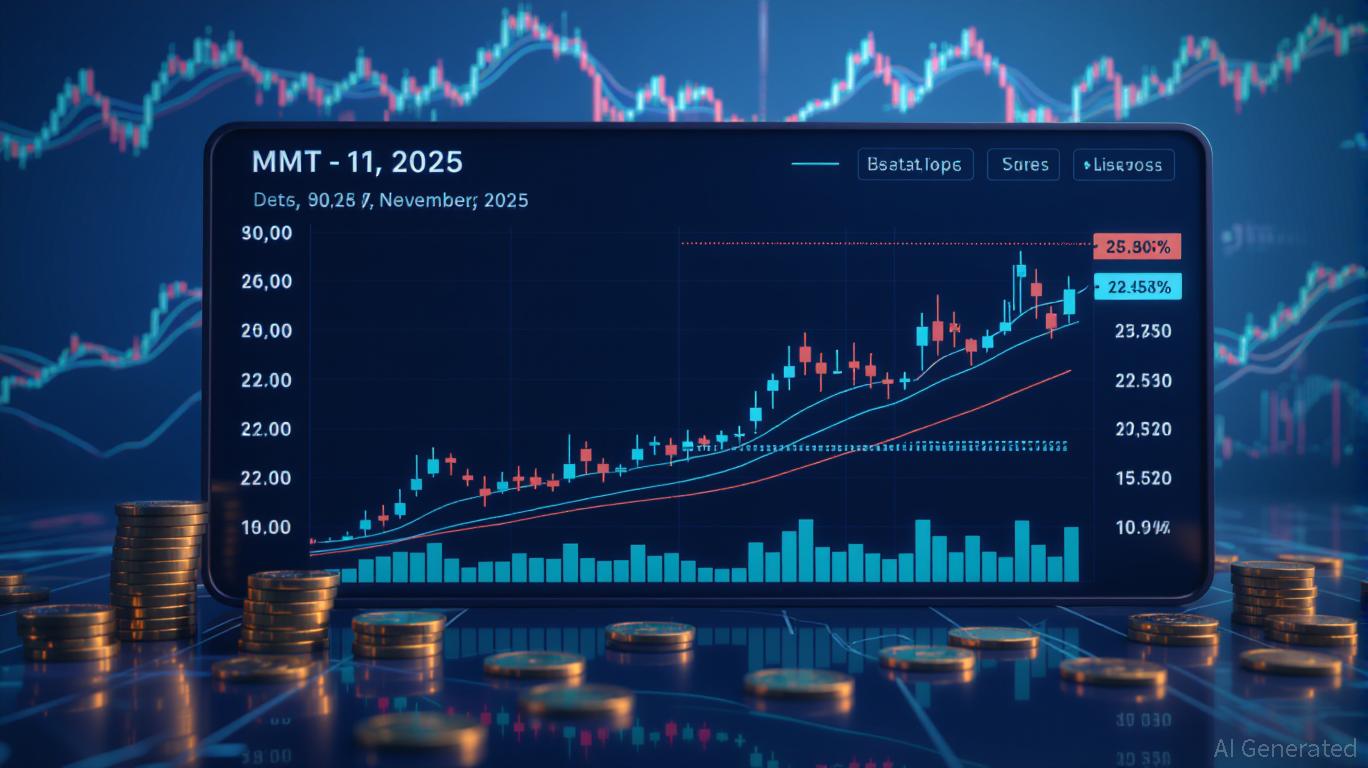Bitcoin’s harmonic formations indicate evolving market behavior, challenging previous cycle patterns
- Bitget analysts identify a Bearish Bat pattern on Bitcoin's 1-hour chart, projecting a 3.68–4.51% rebound to $109,512–$110,382 as the pattern completes its final CD leg. - The pattern's validity depends on breaching the PRZ at $110,000, which could trigger short-term buying momentum amid reduced volatility from institutional adoption and ETF approvals. - Bitcoin's 26% recent pullback contrasts with historical 77–84% declines, reflecting maturing market dynamics driven by long-term holder accumulation and

Technical signals for Bitcoin (BTC) currently point to a possible short-term bounce, as a distinct harmonic pattern is emerging on its 1-hour chart. Bitget analysts have spotted a Bearish Bat formation, a chart pattern that often highlights potential reversal areas (PRZ) at important Fibonacci retracement points. The pattern is now completing its final CD segment, with anticipated price targets ranging from $109,512 (0.886 Fib) to $110,382 (1.0 Fib) title2 [ 2 ]. This indicates
The Bearish Bat pattern is generally interpreted as bullish until it completes, and its appearance coincides with Bitcoin’s rebound from the $102,000 support level after escalated tensions between Israel and Iran. Whether the pattern holds will depend on Bitcoin’s ability to break through the PRZ, which could spark a surge of short-term buying from both traders and institutions. Should
Bitcoin’s price trends are being shaped by shifting market forces. The traditional four-year cycle, which has historically been linked to halving events, appears to be changing due to factors like the launch of U.S. Bitcoin ETFs, increased institutional involvement, and clearer regulations. Matthew Hougan, Bitwise Asset Management’s chief investment officer, pointed out that the 2024 halving lined up with a record high of $73,000 in March 2024—months ahead of the event—unlike previous cycles where peaks came 12–18 months after the halving. This change highlights stronger institutional demand and reduced price swings, as long-term holders and steady inflows help prevent sharp corrections title1 [ 1 ].
Recent downward corrections have also been less drastic than in past cycles. For example, the largest drop in the current cycle has been about 26%, much less severe than the 77–84% declines seen in 2017 and 2021. Ryan Chow of
For market participants, the harmonic pattern presents a strategic chance to benefit from Bitcoin’s short-term momentum. Completion of the pattern at the PRZ could coincide with a broader rally, especially if macroeconomic factors remain supportive. However, the effectiveness of this setup depends on Bitcoin’s ability to sustain liquidity and avoid renewed volatility from external shocks. Experts advise keeping an eye on key levels, such as the $105,000 support and $110,000 resistance, as well as monitoring the global geopolitical environment for possible disruptions title2 [ 2 ].
The significance of this technical formation goes beyond immediate trading tactics. If Bitcoin continues to break away from its historic four-year cycle, it may indicate a transition to a more mature, macro-driven market structure. This would be consistent with the increasing integration of crypto assets into mainstream finance, as shown by the approval of spot ETFs and the accumulation of Bitcoin by publicly traded firms. As institutional involvement grows and regulatory standards develop, Bitcoin’s price movements may increasingly mirror broader economic trends, rather than being dictated solely by on-chain events like halvings title1 [ 1 ].
Disclaimer: The content of this article solely reflects the author's opinion and does not represent the platform in any capacity. This article is not intended to serve as a reference for making investment decisions.
You may also like
Solana News Today: "Solana Treasury Allocates Billions in Staking, Offering 7.7% Returns Amid Ongoing Market Skepticism About Crypto Rebound"
- Upexi , a Nasdaq-listed Solana treasury firm, reported $66.7M net income in Q1 2026, driven by $78M in unrealized gains from its 2.18M SOL holdings. - The Solana treasury sector now holds 24.2M SOL ($3.44B), with Upexi ranking fourth and staking yields averaging 7.7% as a corporate asset class. - Market volatility triggered defensive moves like Upexi's $50M share buyback, while its stock trades at 0.68x NAV amid broader crypto skepticism. - Solana's on-chain activity outpaces Ethereum , with TVL reaching

COAI's Significant Price Decline: The Result of Leadership Instability, Ongoing Legal Issues, and Ambiguous Regulatory Environment
- COAI Index fell 88% YTD in 2025, driven by AI/crypto AI sector selloff amid governance failures and regulatory uncertainty. - C3.ai's leadership crisis and unresolved lawsuit eroded investor trust, compounding COAI's decline as index cornerstone. - Vague CLARITY Act left AI-based crypto projects in legal gray zones, triggering risk-off trading toward established tech stocks. - C3.ai's $116.8M Q1 loss and sector-wide weakness highlighted structural risks despite 21% revenue growth. - Analysts debate if CO

MMT Value Forecast and Investor Outlook for November 2025: Evaluating Reliability During Economic Changes
- MMT token surged 1,300% in Nov 2025 due to Binance listings, airdrops, and institutional investments. - 1607 Capital increased MMT-linked fund stake by 84.7%, but dividend sustainability remains unclear. - Fed policy and missing inflation data (due to 2025 government shutdown) cloud macroeconomic alignment. - MMT's volatility ($4.40 to $2.54) highlights speculative nature despite structural catalysts. - Long-term credibility depends on macroeconomic clarity and Fed policy shifts, not just exchange-driven

LUNA Declines by 0.62% as Ongoing Yearly Downtrend Persists in Uncertain Market Conditions
- LUNA fell 0.62% on Nov 16, 2025, continuing an 80.61% annual decline amid crypto market volatility. - The drop reflects macroeconomic pressures, regulatory scrutiny, and waning investor risk appetite in digital assets. - Technical analysis shows broken support levels and weak buying pressure, indicating a prolonged bearish phase. - Backtesting reveals sharp declines often trigger panic selling and sector-wide market erosion, compounding losses. - Prolonged depreciation risks eroding investor confidence u